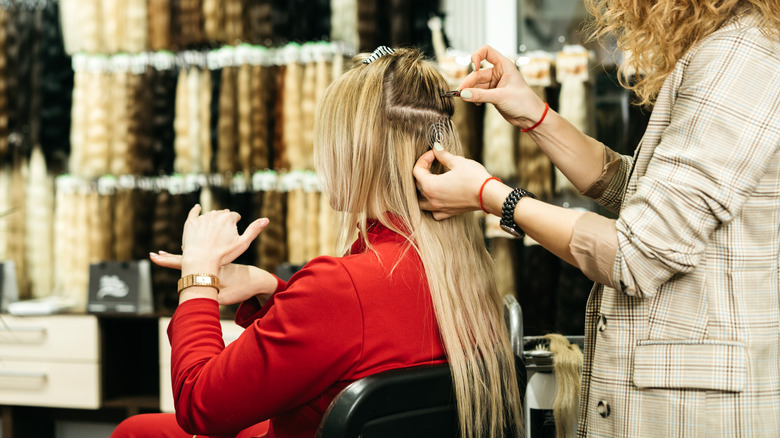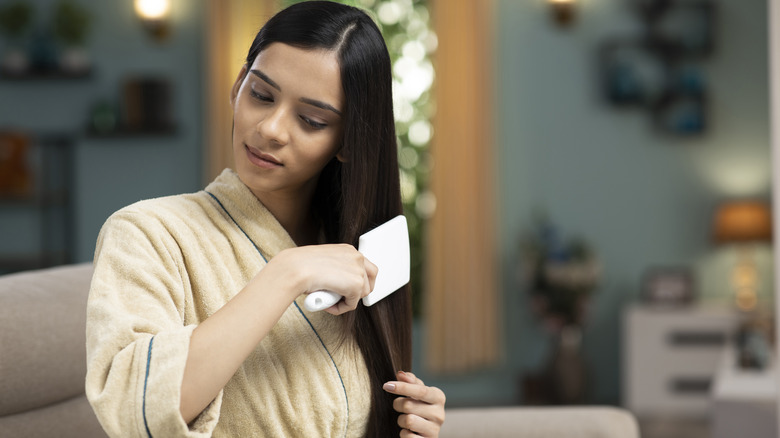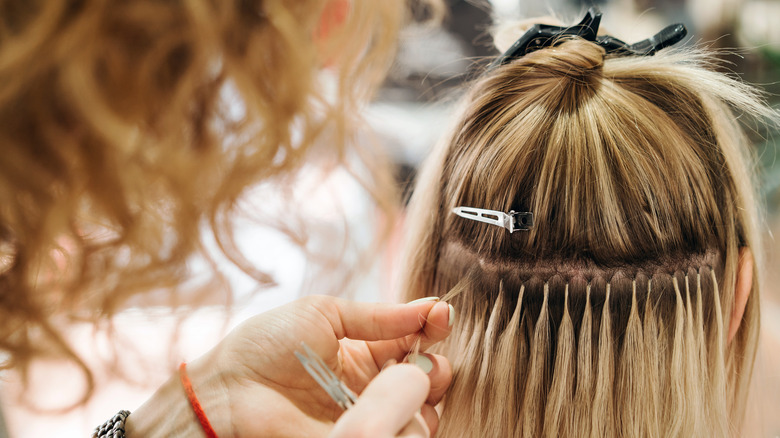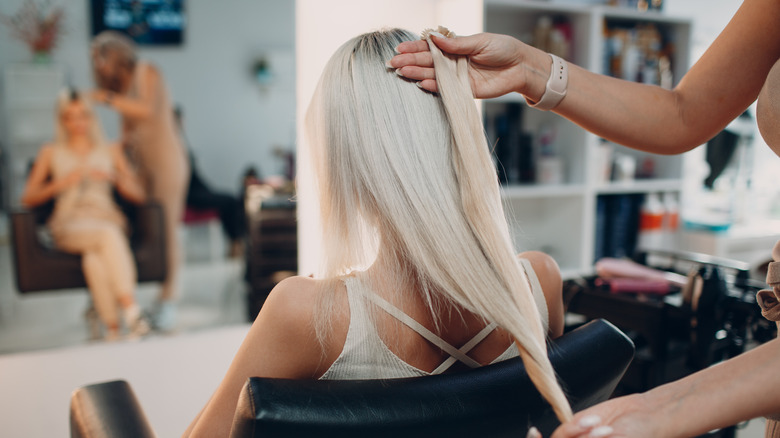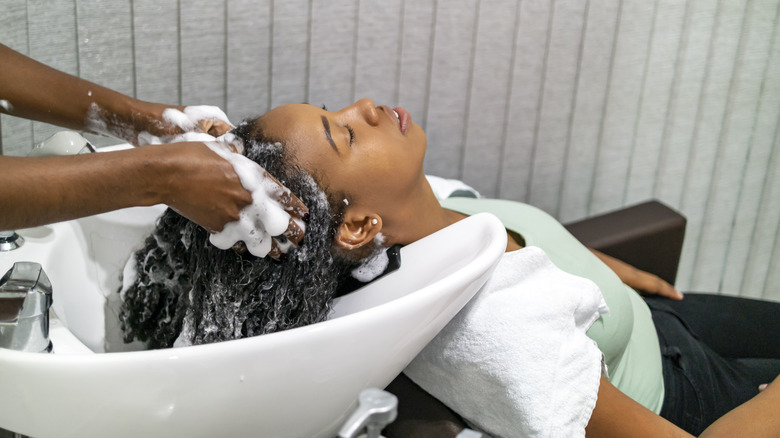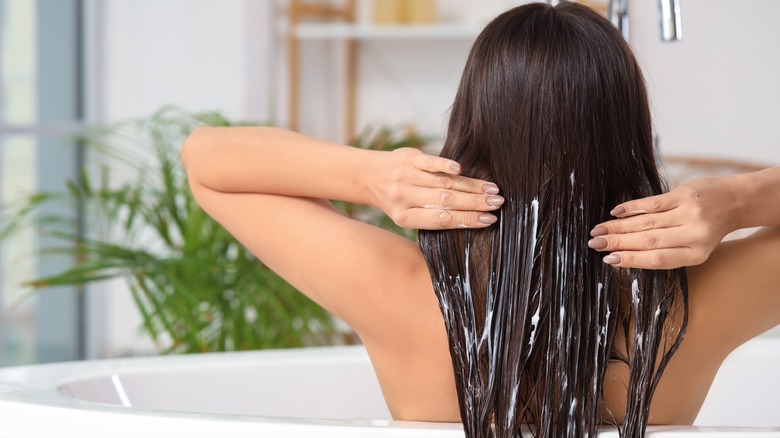5 Things You Need To Do Before Getting Hair Extensions
Whether you want to add length to your locks or are just looking to thicken up your hair, extensions can be life-changing. Especially with super-long extensions coming in and out of style, getting a little help in the hair department is now as common as other staple beauty techniques. There's a range of hair extension types to suit people from every walk of life, from temporary clip-ins and halo pieces to semi-permanent tape-ins and beaded extensions. But regardless of the kind of hair extensions you go with, it's important to prepare properly before you get them, particularly in the case of more permanent options.
In an exclusive conversation with Glam, Stephanie Angelone, master stylist at RPZL Hair Extension & Blowout Bar in New York City, reveals that there's not much physical prep you need to do before getting your extensions, as long as "your hair is in healthy shape and a candidate for an extensions application." However, most of the preparation comes through the research that's essential before committing to long-term extensions. Since there are so many different kinds of extensions, it's important to consider your situation to settle on the right type for you and get professionally color-matched to ensure you end up with the best result. Then, you can focus on prepping for your actual appointment, which comes down to ensuring your hair is free from buildup that can jeopardize your application.
Make sure your hair is healthy before getting extensions
Stephanie Angelone says that the single most important thing to do before getting extensions is making sure your hair is healthy enough for them. Though some kinds of hair extensions do more damage than others, all types can put some strain on your locks (with temporary clip-ins and halo extensions causing the least amount of damage). In particular, making sure your hair is healthy enough to withstand the more permanent types of extensions includes avoiding intense chemical hair treatments. "Prior to your extensions appointment, the only key thing is that you haven't had any chemical treatments that aren't too harsh on your hair such as Japanese straightening, perms, etc.," Angelone tells Glam exclusively. "If you have, you should wait at least two to four weeks to apply a permanent extension."
Your hair stylist will be able to tell if your hair is damaged, but there are also signs you can probably see for yourself. These include thin, dry ends, hair that often falls out and tangles, and an overall dull appearance. If you're trying to differentiate between damaged, broken hair and new growth, remember that damaged hair often feels coarse, while new growth typically doesn't appear in clumps in specific areas of the scalp.
Research the kind of extensions you want
In our exclusive chat, Stephanie Angelone specifies that there's not a lot of physical prep you have to do before getting your extensions, but a crucial step is researching the different kinds available to know what's best for you. You can do this by chatting with your stylist, who likely knows your hair and lifestyle, but it also helps to look at the pros and cons of each extension type and understand how they work.
Fusion hair extensions, which are sometimes called keratin bond extensions and fuse to your hair with adhesive, are among the most common types of long-term extensions. Additionally, there are microbead hair extensions, which adhere to the hair through small beads. There are also tape-in extensions that are pre-taped and pressed onto either side of a section of your hair, along with weft extensions, which feature rows of hair that are threaded into the natural hair. Each kind of hair extension has a different lifespan and slightly different care and maintenance requirements, along with different costs, so only invest in those that you can commit to.
Some brands are also more responsible than others when it comes to ethically sourcing human hair, so be sure to do your research into the company providing the extensions. Overall, you should think about hair extension type, maintenance, price, and sourcing before ordering them from your stylist or buying them yourself.
Color-match your extensions
Once you know what extensions you want, have ensured that your hair is healthy enough to wear them for the long term, and as Stephanie Angelone tells us exclusively, avoided chemical treatments leading up to your appointment, the next step is to color-match. If you plan on buying your extensions online and taking them to your hairdresser to apply, you may find that it's hard to settle on the exact right shade. And while many brands will allow you to return the hair in exchange for another color, this can get tiring and expensive when there are lots of shades to choose from.
The best way to approach this part of the process is having your hairdresser color-match your hair for you. In many cases, they will have a swatch of samples in the salon so they can physically find the right color against your real hair before ordering in your extensions. Though this may require an extra appointment, it's worth it to avoid the hassle of trying to find your perfect match yourself.
Prepare to have your hair washed during your application appointment
After the research and color-matching is done, you're finally ready for your application appointment. Stephanie Angelone says that most stylists will wash your hair during the appointment, so there's no need to pre-wash your locks. "If you're getting extensions your stylist will wash you with a clarifying shampoo," she shares exclusively with Glam, adding that the stylist "may condition the ends" if they're knotty.
Extensions should be applied to dry hair, so your stylist will then blow dry your hair to prepare for the next step. While you technically can wash your hair and dry it before you get to the salon to reduce your appointment time, be sure to let your stylist know this in advance so they're prepared. "Usually stylists like to wash and blowout your hair themselves ... which will result in a seamless application so your extensions will have long lasting results," Angelone explains.
Avoid oil treatments before your appointment
If you do want to cut down your appointment time and wash and dry your own hair, it's a good idea to avoid using hot oil treatments and other heavy products on your scalp beforehand. Even if you rinse them out well, these can contribute to buildup which can then compromise the application of your extensions. In our exclusive conversation, Stephanie Angelone notes that the main reason stylists prefer to wash your hair themselves is "so they are sure there's no excess buildup of product," but you can help here by avoiding those heavier products in the first place.
Since extensions are applied near the roots of the hair, the main products to avoid are those that go on the scalp. Lightweight products that treat the ends may be okay since they don't directly impact the application process. But as a rule of thumb, steer clear of all products that will weigh down your hair and create an oily finish, since this can affect the look of your extensions.
